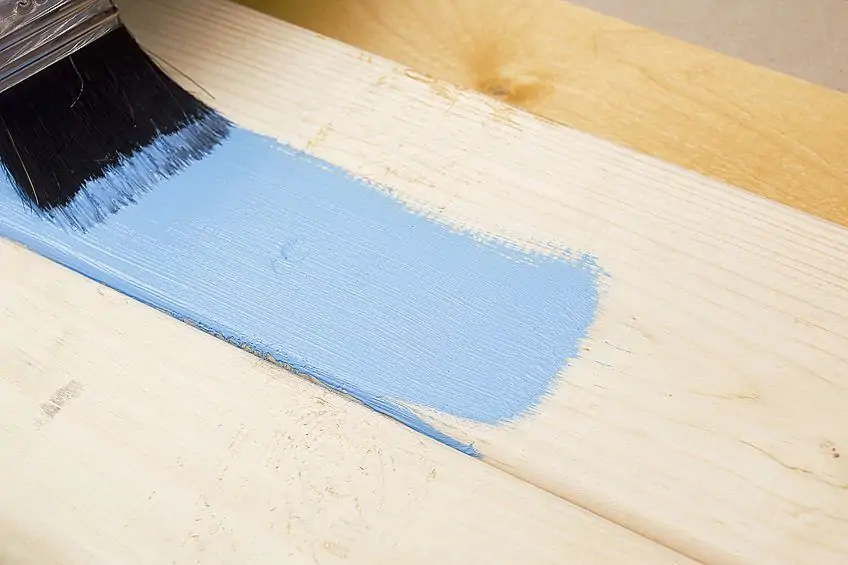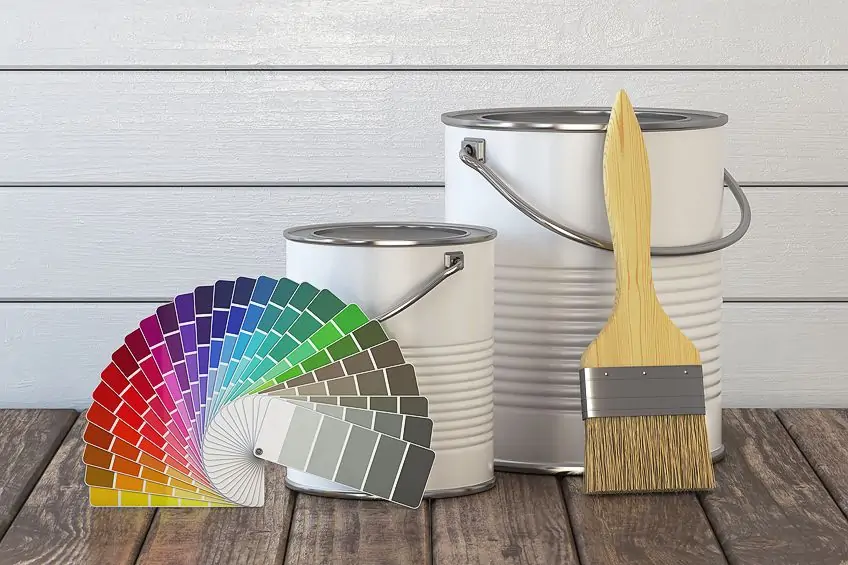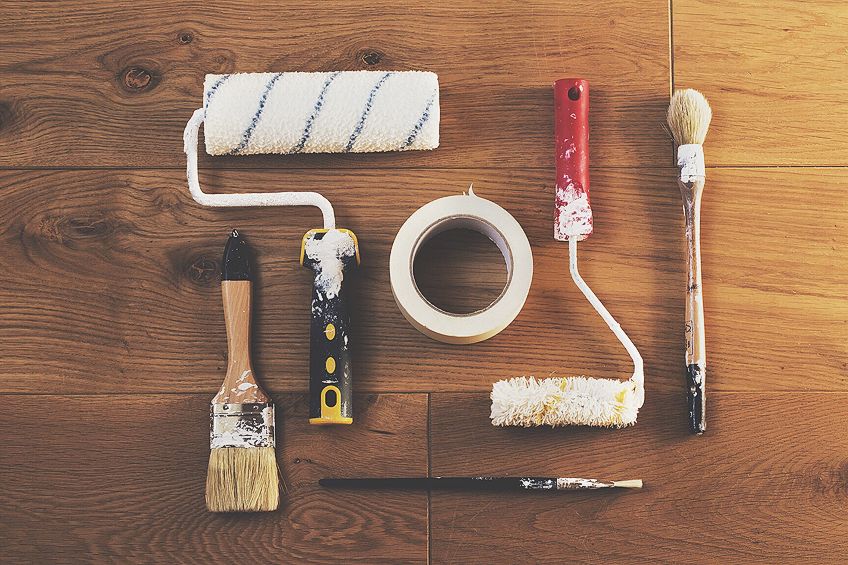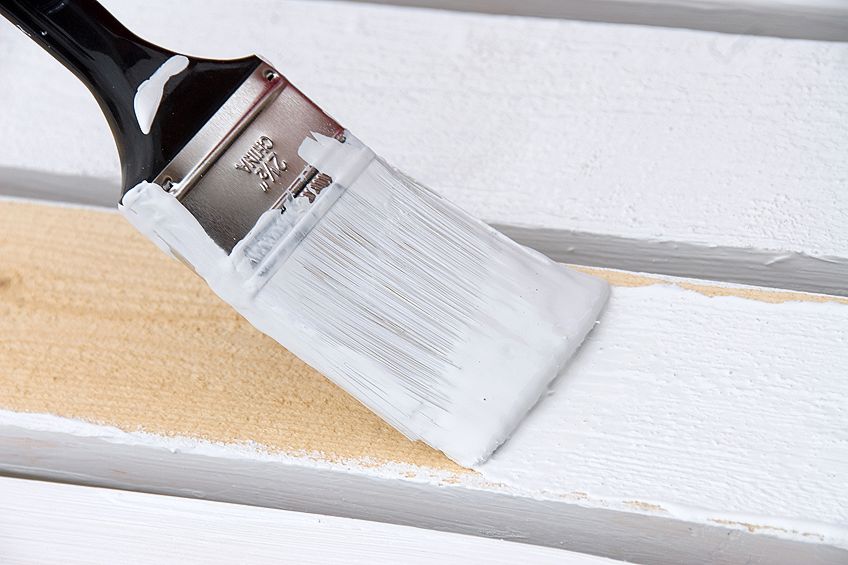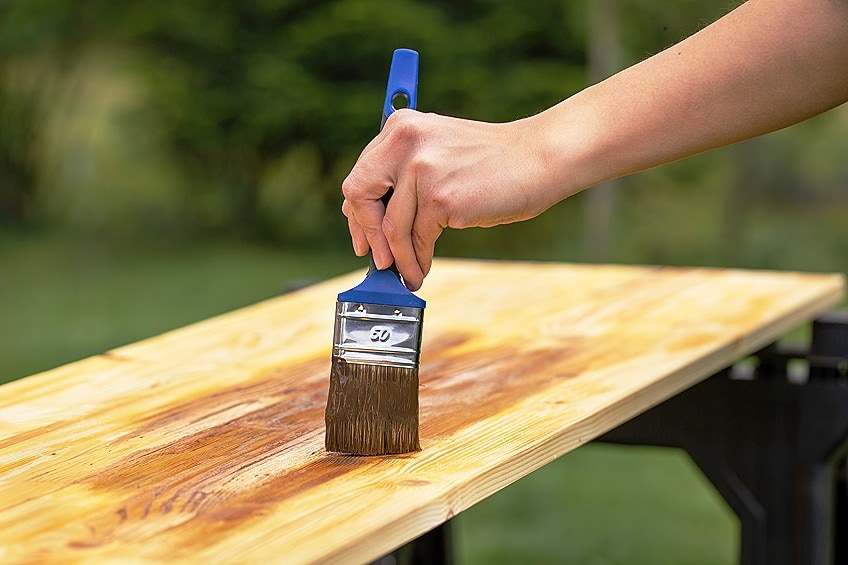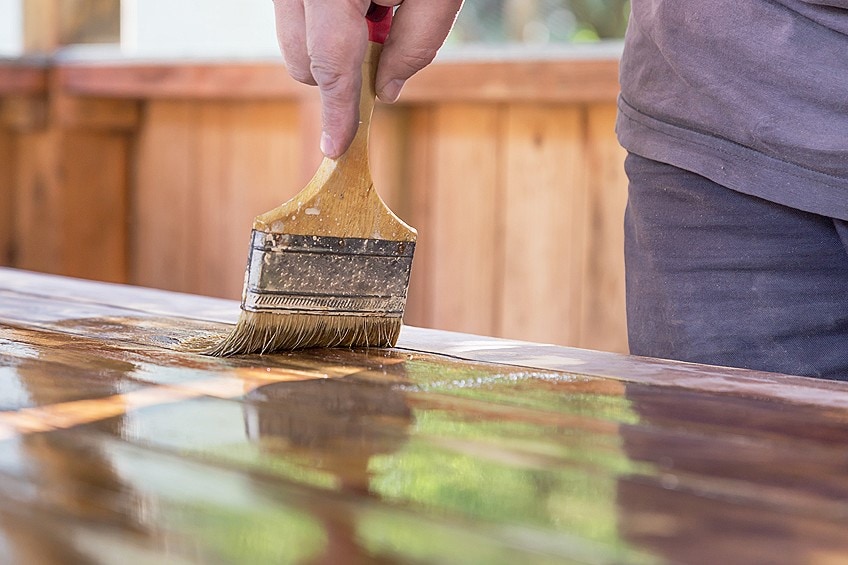Best Outdoor Paint for Wood – A Guide to Using Exterior Wood Paint
This post may contain affiliate links. We may earn a small commission from purchases made through them, at no additional cost to you. You help to support resin-expert.com
Whether winter is coming up or you simply want to give your home a new coat of color for the summer, you’re going to need some paint. Paint is one of those things that you rarely think about until you need it, and when you do, it can be impossible to think about anything else. This rings true particularly when you are painting something that will spend its lifetime outdoors. Which color do you pick? Will the paint last? Can it take the heat? What if it snows? There are a lot of factors to consider, so let’s have a look at what you should consider when selecting paint for outdoor wood.
Table of Contents
Which Paints Work on Outdoor Wood?
There are lots of paints on the market for all sorts of applications, each of which can make a considerable difference in the aesthetic appeal of a surface. However, not every paint is well suited for outdoor usage. Certain paints are far more resistant to changing weather conditions, ambient temperature, rot, and termites, so it’s important to know which paints are best suited to handle these forces. Below is a short list of paints and the properties that allow them to handle outdoor conditions.
| Type of Paint | Does It Work on Outdoor Wood? |
| Oil Paint | ✔ |
| Acrylic Paint | ✔ |
| Latex Paint | ✔ |
| Flat Paint | ✘ |
| Eggshell Paint | ✘ |
| Watercolor Paint | ✘ |
| Gouache Paint | ✘ |
Oil Paints
Oil paints are generally a good choice for any wood surface you’d like to paint. Why, you may ask? Well, the nature of oil paint and its composition makes it an ideal coating for most surfaces, including metals and certain plastics.
Oil paints have a very distinct make-up due to the oil compound in their base, which allows the paint to seep into tiny recesses and bond with the surface (to an extent).
This is great for you because it means that instead of just coating the surface in a layer of paint, the paint actually becomes part of the workpiece. On the one hand, this is good for surfaces that are exposed to harsh conditions, but on the other hand, it can be troublesome to remove once applied. Oil paint is also water-resistant and resistant to heat for the most part once dried.
Acrylic Paints
Acrylic paints are great too. This type of paint might typically be less expensive than oil-based paints, which might lead you to believe that it might not be as good a fit as the aforementioned. However, this is not the case. Acrylic paint is typically cheaper because it is easier to manufacture compared to oil-based paints. In fact, most paints used on home exteriors including brick, wood, and ceramic surfaces are acrylic or latex-based paints.
In recent years, this type of paint has outgrown oil-based paints in popularity due to the price difference and availability. Even though acrylic paints don’t adhere to surfaces in the same manner as oil-based ones, they still provide great protection against external forces as well as bright and radiant colors.
Acrylic paints will also provide you with a wider range of colors compared to oil-based paints, allowing you to personalize workpieces without having to shop around too much.
Latex Paints
If you know a thing or two about paints in general, you might be thinking that latex paints and acrylic paints are the same, and they are, aren’t they? Well, you wouldn’t be completely wrong. Acrylic paints and latex paints are pretty similar because they contain a lot of the same substances used in the manufacturing process, although latex paints are primarily water-based where acrylic paints are based on a mix of chemicals.
Knowing this, latex paints are not quite as resistant to harsh weather compared to acrylic paints because of their water base, although we should mention that latex paints have come a long way since they were first introduced into the consumer market, and now last far longer than one would imagine.
This being said, although latex paints are graded for use outdoors, they can’t take quite the same beating as acrylic- or oil-based paints can.
This is why you should be wary of the conditions your workpiece might encounter if you choose to use latex paint. Lighter weather conditions will not dramatically affect the finish or adhesion of latex paints, but harsher weather conditions such as torrential downpours or extreme heat might cause your finish to lift, crack, or split.
The Best Outdoor Paint for Wood
Objectively, there are only two types of paint that could be considered the best outdoor paint for wood, being acrylic- and oil-based paints. However, this is generally speaking, as there are many paints out there that are conducive to applications that don’t require iron-clad protection (and might even provide a better finish!). This being said, let us have a look at some products that we consider to be the best outdoor paint for wood.
Best Overall: RUST-OLEUM Zinsser PermaWhite Exterior Satin Paint
If you’re in the market for reliable paint that won’t break the bank while still affording you a premium quality finish that lasts, Rust-Oleum’s Zinsser PermaWhite paint might just be for you. Rust-Oleum is a brand that has been around for nearly 100 years and has developed a loyal customer base among private consumers and business contractors alike. Many consider the Painter’s Choice to be the best waterproof paint for wood.
- Self-priming formula that requires no sanding
- Mold- and mildew-proof paint film lasts for 5 years
- Easy to clean and resists dirt and moisture on film coating
Their latest innovation in their Painter’s Choice line is the Zinsser exterior paint. This line of products offers a professional finish that could take your workpiece or the exterior of your home to the next level, inducing curb appeal and envy in anyone lucky enough to see it as they walk by. Besides a great aesthetic improvement, this paint is extremely effective as an outdoor paint that offers superior protection against things such as heat, moisture, abrasion, and mild impact resistance.
In addition to all of the aforementioned, this paint will save you a ton of time, especially if you are working on larger workpieces. This is due to its self-priming formula, which saves you hours in the preparation stage.
The Rust-Oleum team claims that this paint can be applied to wooden surfaces with no sanding needed whatsoever, and although this might be hard to believe, especially if you have an existing coat you’d like to remove, we think it’s a nice touch on their part. Although it’s only sold in one color, the satin white is a beautiful finish and is quite reasonably priced considering it’s a high-quality combination of paint and primer.
PROS
- Graded for exterior use
- Dries quickly
- Combination paint and primer
- Strong color finish
- Easy to use
- Reasonably priced
- Durable
CONS
- Only available in one color
- Difficult to remove
- Not very thick
Best Finish: KILZ Exterior Siding, Fence, and Barn Paint
There are many paints that do everything extremely well – those all-purpose variants that claim they can do everything and anything you might need, and they might even be cheaper than reputable brands! In reality, these paints rarely live up to their reputations and end up being more of a watery mess than anything else. If only there was a team that was dedicated to developing a paint like this that actually worked…
It looks like the Kilz team thought the same thing, and it shows in their latest exterior wood paint, which really does all of the above and more, featuring a formula that not only works like a dream on wooden surfaces but on brick and some sheer surfaces as well.
- Offers coverage and protection against the elements
- Features a unique water/oil base formula for exceptional adhesion
- All-purpose exterior paint resists cracking, peeling, and blistering
This paint doesn’t just stick well though. The Kilz team has gone above and beyond to ensure that their product is resistant to even the harshest weather conditions including extreme heat, hail, rain, and extreme buffeting from sand caused by harsh winds.
This paint is intended for use on hard-wearing surfaces such as exterior decks, tables, chairs, and fences, which is why it’s been designed to be virtually bulletproof as a coating.
What’s more is that you can get a gallon of this stuff, allowing you could resurface your entire outdoor furniture set, your backyard fence, or the front-facing wall of your house and still have some leftover in case anything else catches your eye at a later date. Still not convinced? Well, if the quality, price, and versatility don’t quite have you sold yet, the fact that it is self-priming and dries in under 40 minutes should put the icing on the cake for you.
PROS
- Good quality
- Reasonably priced
- Versatile
- Robust
- Easy to use
- Heat-resistant
- Water-resistant
CONS
- Uncharacteristically long drying time
- Only available in two colors
- Availability can vary by state/region
- Quality can differ according to the application method
Best Value: CUPRINOL Garden Shades Exterior Woodcare Paint
Although all of the paints we have looked at thus far have been outdoor paint for wood, they have all been rather general-purpose products with a wide range of applications. The Cuprinol team, on the other hand, has chosen to create a paint for one setting in particular: your beloved garden!
Even if you aren’t a stickler for garden maintenance and don’t mind your fence looking a little shabby during the winter months, the Garden Shades range from Cuprinol has you covered, whether it be a touch-up on your old porch or refinishing your garden gazebo.
- Beautiful matte color enhances the grain of natural wood
- Protects wood and other surfaces from weather for up to 6 years
- Easy to apply, quick-drying, and easy to clean
Their exterior wood paint is graded for the toughest domestic conditions and, although it might not have the sheen finish that other wood paints have, it more than makes up for this in the types of garden surfaces you should be able to use it on. Painting usually involves only the workpiece you set out to paint at first, followed by something you notice out of the corner of your eye that could use a touch-up.
For most people, this rings especially true when working on garden projects. Maybe you noticed that your old birdhouse could use a fresh coat of paint? What about that stone water feature that’s lost its finish?
Well, if this situation sounds familiar to you, this outdoor paint for wood is exactly what you’re looking for, and if the weather is a bit unpredictable in your area and you’re concerned about drying time, don’t be. Cuprinol’s Garden Shades collection dries within the hour, and although it isn’t self-priming like the other products, we mentioned previously that it will undoubtedly save you a ton of time and effort in the long run!
PROS
- Versatile
- Easy to use
- Specifically designed for garden surfaces
- Matte finish is easier to maintain
- Great adhesion quality
- Compatible with sprayers and brush/roller
- Quick drying time
CONS
- Only designed to work on garden surfaces
- Not self-priming
- Finish might not fit every environment
- Only three color options available
How to Apply Paint for Outdoor Wood
After seeing those outdoor paint reviews, you’re probably wondering what the best way to go about applying them is. Fortunately, we have you covered. You could probably glean from these exterior paint reviews which qualities you should look for in paint, and you might even know exactly which paint for outdoor wood you’ll be using. This being said, let’s have a look at some of the tools you will be needing and how to use them to make sure that your next outdoor project looks great! Below is what you will need to get started:
- Paint
- Primer
- Sanding paper/power sander
- Brush and roller or a paint sprayer
- Tarp/plastic/newspaper
- Gloves
- Face mask (filtered)
- Sealer (optional)
Prepare Your Workspace
When painting anything, the key is in the preparation of both the workpiece and workspace. Preparing your workspace adequately means that you spend less time running around looking for tools and clothes, as well as less time cleaning up after yourself once you have accomplished your mission. It is especially important to prepare when working with outdoor wood, particularly if the workpiece cannot be moved and you need to paint on location.
Firstly, put down a floor covering in the area you are working and use some painter’s tape to mask up any areas of the workpiece or your immediate environment that you don’t want to get splattered with paint. This is a step you should take care with especially if you plan on using a paint sprayer. Next, ensure that your tools are readily available and easy to access by placing them on the side of your dominant hand with your workpiece directly in front of you.
You must also ensure that the area is well ventilated (not a problem if you will be working outdoors) and that you have all of your personal protective gear ready before you move on to the next step in the process.
Prepare Your Workpiece
You will then need to prepare your workpiece before you can get to painting. This includes ensuring that the wood is completely clean and clear of any dust, oils, or other residues. It is usually a good idea to sand the wood before painting, as this not only removes any uneven pieces or old bits of paint, but it also provides a rougher surface onto which the paint can adhere. Do not forget to wash the wood again after sanding to remove any further dust, and ensure that the wood is completely dry before moving on to the next step.
Prime Your Workpiece
Priming your workpiece properly is a fundamental step in any painting process. If you have chosen to use self-priming paint, it will save you a considerable amount of time as you won’t have to wait for the primer to absorb and set into the wood. If you have chosen to go with ordinary paint, you should ensure that your surface is well primed and set before you apply your paint.
If your primer is applied incorrectly, this could result in your paint adhering poorly. Even if you have used a high-quality paint with great adhesion in its own right, it could cause your paint to rise, crack, or bubble in a relatively short period of time when exposed to harsh weather conditions.
This being said, when applying your primer to outdoor furniture, you should ensure that you coat not only the face of the board but all of the small spaces, grooves, hinges, and recesses that might otherwise go unnoticed.
Applying your primer with a brush might put you at a slight advantage considering that you will be up close and personal with the workpiece, so spotting these areas will be more likely. However, with a paint sprayer, you tend to have more of a bird’s eye view, so you might miss a few spots. On the other hand, you do have the advantage of applying multiple coats of primer a lot faster and with a lot less elbow grease should you choose to use a sprayer, which means that the choice is yours as to how to go about it.
Either way, ensure that your primer has dried for the manufacturer’s recommended time period before moving on to the next step.
Paint Your Workpiece
Once your primer has been set, we recommend giving your workpiece a very light sanding one more time before you apply your paint. Ensure that your workpiece is free of any wood particles by dusting any off with a dry cloth.
Now for the part that you have been waiting for! Get your paint and prepare it by following the manufacturer’s instructions. Some paints (especially self-priming ones) need to be shaken up a bit before they are used, or you might not get the desired finish.
Once your paint has been prepared, you should begin painting. If you are using a brush and roller set-up, ensure that you use a roller with a fine nap as they work best with paint for outdoor wood, and also ensure that the head of your brush is an appropriate width for the board size you’ll be painting.
You should paint following the length of the board in the interest of efficiency and getting paint into all of those hard-to-reach places. We suggest using the roller for the meat of the work and using the brush to touch up spots the roller could not quite get to. If you are using a paint sprayer, ensure that you get a good distance from your workpiece to minimize overspray, splatter, and peel.
Start by spraying away from the workpiece to get a good feel for the pressure of the trigger, and once you have the hang of it, move your wrist over your selected surface in one smooth, uninterrupted motion. If you are right-handed, we recommend spraying from left to right, and if you are left-handed from right to left to ensure a good range of motion.
Apply as many coats as you feel is necessary and allow the paint to dry between coats. Depending on which paint for outdoor wood you have selected, the drying time could vary considerably. Therefore, you should always adhere to the manufacturer’s guidelines for drying times.
Seal Your Workpiece
Sealing your workpiece is optional, although it is strongly recommended considering that the furnishings you will be painting will spend most of their time outdoors. Sealers come in a variety of qualities and compositions for different applications, meaning that you should always check which forces and/or environments the sealer you have chosen is graded for.
Some paints are self-sealing, and others are naturally weather-resistant such as paints graded for use on marine vessels. However, considering that it’s fairly unlikely that you would be using this instead of outdoor furniture paint, a sealer will be needed. We recommend that you apply your sealer with a brush or a sprayer once your paint has dried.
Although the outdoor furniture paint we mentioned previously is what could be considered waterproof (most oil paints won’t allow water through at all), it’s always best to protect not only your wood but also your finish with a sealer, and this doesn’t even require much effort as most sealers only require one coat. Depending on your local climate you could apply two coats, but we’ll leave this entirely to your discretion.
Now that you have an idea of the best outdoor paint for wood should be like, why it’s a good idea or at least a fun project to refinish your outdoor furnishings, how to paint your outdoor furnishings, and what you will need to go about this, it is time for you to go out and put your newfound knowledge to the test! Remember to always wear the appropriate personal protective gear, always ensure that you prepare your workspace before you begin painting, and always work in a well-ventilated area.
Frequently Asked Questions
Does Painting Make Wood Waterproof?
Paint naturally sheds water due to the nature of its composition, which means that coating any wood in paint generally does make it water-resistant. You should keep in mind that even the best waterproof paint for wood will not ensure that your wood is airtight, however. Paint generally wears away due to exterior forces and age, so sealing wood after painting is always a good idea.
What Kind of Paint Do You Use on Outdoor Furniture?
You will find that most spray paints work quite well on outdoor furniture, however, you are not limited to these types of paint for outdoor furniture. Acrylic paints and oil-based paints work rather well on outdoor furniture because of the way they seal and bond to wood in particular, and you can get these in both aerosol form and in conventional containers.
Are There Sprays to Waterproof Furniture?
There are paints you can use to waterproof wooden furniture, but if you would like to waterproof upholstery, you will need a completely different product. There are sprays on the market that use polyurethane as a base to ensure that water runs straight off the natural and synthetic materials from which your couch cushions or favorite lawn chair pillow are made. These are readily available at most home improvement stores and are often overlooked, but they are extremely useful to have on hand.


